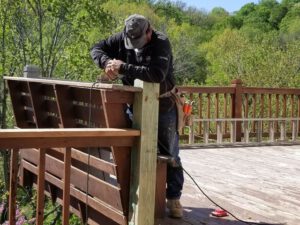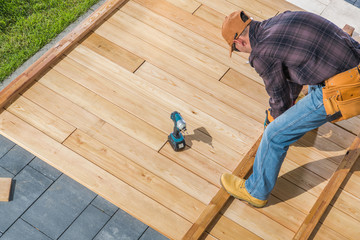Decks take a beating from sunlight, rain, and snow. Deterioration is to be expected, but regular inspections can help spot problems that need repair before they become safety hazards.

If the damage involves rot in weight-bearing posts or beams, repair will be more extensive and expensive than if surface rot only affects one or two planks. A deck ledger is the connecting point between your deck and your home, but it can also be a major source of structural problems. When a ledger board isn’t properly installed or maintained, moisture can leak behind the deck and into your home, causing dry rot. Fortunately, this problem is easily preventable with a little knowledge and proactive maintenance.
Dry rot is a serious and costly problem that can cause significant damage to both your home and deck if left untreated. The best way to prevent it is to ensure your deck remodelers include flashing when they install your new deck. Properly installed flashing is a thin layer of water-resistant material that prevents water from penetrating the junction between your deck and your house. Without proper flashing, moisture will seep into the ledger, triggering persistent dampness and eventually rotting it away.
To repair a rotting ledger, remove the old section and cut two 24 by 2 by 10 inch pieces of wood to scab onto the floor joists on both sides of the removed area. Then, attach the scabs to the floor joists using 3-inch screws. You can also replace the sill plate and ledger board if they are rotted as well.
Insects like termites and carpenter ants love to feast on decks, and if left unchecked, they can destroy your home as well as your deck. Look for signs of insect infestation, including holes in your deck posts and wood flakes on the ground beneath them. If you have an infestation, call a pest control company for assistance.
Rotted Spots
Nothing threatens the life of a deck like moisture and wood rot. While it’s normal for deck boards to splinter or crack, it’s a sign of deterioration when you find rotting spots on the structure. Rotted areas are typically soft, spongy, and discolored. If caught early, the fungus can be killed with a powerful fungicide and the affected area repaired with a wood filler or composite material.
To identify rotting wood, look for long sheets of grayish mold or darker-looking patches on the decking surface. You may also notice that the surrounding wood has a distinct musty odor. It’s important to note that wood-eating insects, such as termites and beetles, often attack rotted areas as well. If you suspect a problem, locate the source of the water and address it as a first step to preventing future rot. This could include a plumbing leak, a gutter alignment issue, a sprinkler system problem, or anything else that encourages water retention.
Dry rot fungus is difficult to kill once it’s established. In fact, the pores of this type of fungus can actually grow even in the presence of a fungicide. This makes it critical to address the entire situation with a thorough inspection, the removal of all rotted wood, and the treatment of all nearby timbers with a fungicide to stop the spread.
In some cases, the fungus can be killed with oxalic acid. This is a chemical found in some deck cleaners and may be purchased from hardware stores. It’s crucial to wear eye protection and gloves when working with concentrated chin scanning. It’s also a good idea to prune any plants that might be near the damaged areas, as some deck cleaners can burn leaves on contact. When using a power tool to cut away rotted sections of timber, it’s best to support the board above with lumber to prevent binding and slipping as you saw through it. This will also make it easier to finish the rotted section with a stain or paint that matches the rest of your deck. Once completed, be sure to sand down the repair to smooth it and stain it with a solid color rather than a semi-transparent stain for maximum longevity.
Cracked Wood
Wood cracks and splits are a natural part of the growth cycle, but if they go untreated, they can ruin furniture or other projects. Fortunately, there are several ways to repair them. The most common is to use a sealant or stabilizer that will prevent the cracks from spreading further, but there are other methods as well. Some of them include using epoxy or sanding and sawing the crack to make it shorter and less visible. Others involve incorporating the crack into a design, which can be an aesthetic accent and even add a unique style to the piece.
Identifying the source of the crack is important before trying to correct it because improper diagnoses often lead to the wrong course of action and more damage. It’s also important to understand that wood swells when it’s wet, then shrinks as it dries. This can cause a tabletop to twist, warp, or even separate from its base.
There are several types of wood fillers, but epoxy is best for this type of repair. The first step is to prepare the artwork by sanding and cleaning it. Then, mix the epoxy components: resin and hardener. When they’re combined, the mixture should be paint-like in consistency. If the knots twist, dwarf, or catch the wood, consider adding a drop or two of a wood-colored dye or powder pigment to the epoxy.
Once the epoxy has been applied, sand off the excess and smooth it over with a putty knife. Let it dry as recommended by the manufacturer’s label.
Another good option for cracks in off-edge wood is wood putty, which is thick and durable. However, it is not an ideal choice for this type of repair because it merely masks the crack and doesn’t bind the wood, as wood epoxy does. It’s best for smaller cracks, such as nail holes. In addition, it’s important to avoid storing wood in extremely dry or damp environments or in direct sunlight, as this can contribute to cracking. By taking these precautions, wood can look beautiful for a long time.
Protruding Nails
Oftentimes, deck boards are held in place with nails rather than screws. Over time, these nails can come loose and protrude through the surface of the wood. This is a common problem and one that can be easily repaired with some basic supplies. The first clue that a deck may be experiencing this issue is a visual inspection. If you notice the nail heads sticking up above the board surface or empty nail holes, this can be a sign that the boards are loose and should be replaced. It is important to resist the temptation to simply pound any protruding nails back into place, as this would only be a band-aid over the issue.
The best way to fix this is to pull the nails and replace them with exterior-grade deck screws. Choose screws that are slightly larger in diameter than the nails, and make sure to use a screw with a star bit to lessen the likelihood of stripping. When installing the new screws, it is important to put a piece of scrap wood between your pry bar and the deck board. This will help prevent the tool from denting the surface of the wood and allow you to gain leverage without damaging the board.
Another benefit to using screws instead of nails is that they are much easier to install. This is because it takes far more effort to drive a nail than it does to drill in a screw, and this can lead to fewer errors being made during the installation process.
Once all the old nails are removed and the replacements are installed, it is a good idea to treat the area with a preservative such as stain or sealant to further protect the wood and keep it looking like new. Ultimately, this can help the deck last longer and look its best for years to come.
Lastly, remember that harsh weather can be detrimental to your deck, and if you spot any issues early on, it is better to tackle them now before they get worse. The key is to be vigilant and watch out for signs of damage, such as splinters or a spongy feel to the deck boards, which are indicators of rot.

